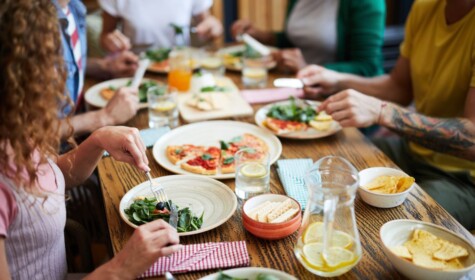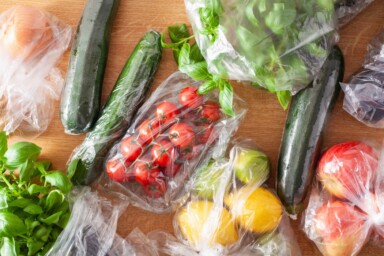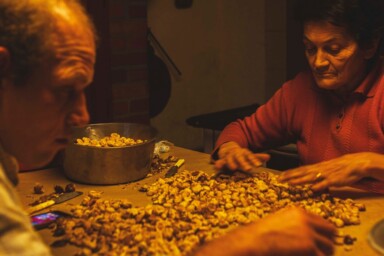The ‘eatwell plate’ of the Food Standards Agency has guided food choices since the 1990s, but it has recently come under scrutiny as sustainable food consumption moves up the agenda. With eating out an important part of our culture, how can the catering sector join the debate and put sustainability on the menu?
This was a key question for the Sustainable Food Summit, held this May in Bristol. Now in its second year, the event brought together a wide spectrum of industry representatives, food-based organisations and myself – a researcher in sustainable food systems – for three hours of productive discussions and workshops tailored to the restaurant trade. With UK consumers’ expenditure on catering services totalling £83.9 billion in 2013, the environmental footprint of the farm-to-restaurant supply chain deserves our attention.
For chefs Tim Maddams and Arthur Potts Dawson, who spoke at the event, sustainability has become their moral imperative. On a sustainability crusade, they advocate farm-to-fork thinking for a successful business and personal life. Both gave passionate speeches on how, in recognising that their impact really does make a difference to diners, they were able to make important changes in the dining experience.
Maddams talked of novel ways to conceptualise a menu, be that in sourcing ‘incidental meat’ such as pigeon, or including under-utilised mutton and offal. They argued that the move to sustainable consumption should really be seen as an opportunity. Diners like novelty, and they are more likely to try something new in a restaurant than during their weekly shop. Diners provide a fertile testing ground for chefs to explore both environmental and economic gains, which encourages a growing consciousness around food production and consumption. Sourcing food locally, for instance, promotes the local economy and shortens supply chains. In turn, this leads to fewer food miles and also a good talking point over dinner.
Maddams’ sustainable plate extends beyond the food on it to include how the restaurant runs. Just because your beef is grass fed and the samphire foraged with your own bare hands, you are not let off leaving the tap running or the oven door open. At the scale of industrial kitchens, this really does make a difference, but for individuals too, small changes accumulate into a significant impact.
The day was a refreshing departure from discussions on the health impacts of food – while health is undeniably important, a holistic perspective is needed on the sustainable plate. And this is very much reflected in the changing face of what British people see as a typical meal.
Why menus look the way they do
Wartime rationing prescribed fair distribution of food and a surge in homegrown produce during the 1940s. We should not forget the ‘dig for victory’ propaganda that is making a well-deserved comeback! However, it was not until the 1970s that a guideline for how to eat was developed Europe.
Gripped by high food prices, Sweden created a food pyramid detailing the ‘correct’ servings of foods, from breads and cereals to fats and oils. It was intended to offer ‘good wholesome food at reasonable prices’. No health claims were made.
The US Department of Agriculture (USDA) adapted the food pyramid for its market shortly after. Heavy lobbying from the food industry had a significant influence on the types and amounts of food that appeared on this version. As nutritionist Luise Light, former USDA insider, explains:
“Where we, the USDA nutritionists, called for a base of 5–9 servings of fresh fruits and vegetables a day, it was replaced with a paltry 2–3 servings… changes were made to the wording of the dietary guidelines from ‘eat less’ to ‘avoid too much’, giving a nod to the processed food industry interests by not limiting highly profitable ‘fun foods’ (junk foods by any other name) that might affect the bottom line of food companies.”
Similarly, Britain’s ‘eatwell plate’, developed in 1994, was also subject to industry lobbying; you only have to look at the Kellogg’s box that appears in some versions to see the blatant influence. Alternative ‘healthy eating’ plates are out there, such as My Vegan Plate, although this still suggests between six and eleven servings of carbohydrates, which by some accounts is too high.
Proposals for sustainable eating
For the first time in 20 years, the eatwell plate has been given a makeover. The World Wildlife Fund have proposed a Livewell 2020 Diet, which sees an increase in vegetable consumption by two per cent and a decrease in ‘non-dairy protein’ to balance the plate. It calculates the relative contribution to greenhouse gas (GHG) emissions for each slice of the pie and offers a useful model around which to base menus – one that is based on exploration and experimentation. However the Livewell Diet still suffers from some of the same flaws as its predecessors, and foods high in fat and sugar have even increased. Further, neither locality nor seasonality is mentioned in the Livewell Diet. So, while embedded GHG emissions can be reduced by 25% if we all adopt this diet, it is, again, far from a holistic picture of sustainable eating.
A 2008 study calculated that even if reducing food miles to zero was achievable, the savings on this for GHG emissions would only equate to 5% – the equivalent of driving just 1,000 fewer miles a year. By comparison, one meat and dairy free day per week would save 1,160 miles. In cutting back on meat, diners begin opening their minds to alternatives and thinking differently about their food. It can be a unique selling point for caterers.
Friends of the Earth (FOE) propose the ‘Flexitarian’ diet, which is defined as mainly plant based, but allows small amounts of meat, fish and dairy. FOE have ambitions of making Bristol into Britain’s first Flexitarian city. The average daily water consumption of a meat-eating person is 5,000 litres per day: the average vegetarian uses half of this. So with drought predicted to become more frequent in the future as a result of climate change, we need to evaluate more carefully the impact on our water resources of how we eat.
Another novel idea, which Luke Hasell, farmer and director of Eat Drink Bristol Fashion, is championing, is increasing the age of slaughter for farm animals. In doing so diners will not only have a tastier morsel to savour, they will reduce the need to house so many animals: tender cuts of meat require that animals move less and are thus kept in confinement, raising animal welfare issues. It’s a no brainer really: the diner leaves satisfied and the welfare of the animal is improved.
Nothing goes to waste
Food is wasted at each step of the supply chain: it remains unpicked if it is ‘ugly’; it perishes over long distances; it is ‘trimmed’ for aesthetics; and it is left on the plate of not-so-hungry customers. Caterers have the ability to intercept at each of these junctures. They can champion crooked carrots, source local food in season, use peelings for stocks and offer different portion sizes. And when waste remains, they can donate surplus to food waste charities such as Foodcycle. At the Sustainable Food Summit, Dawson even went so far as to say “why give diners so much choice?” And why not provide just one or two options? It is a bold statement but perhaps a necessary one.
Building a brand
Citing a regionally sourced product on the menu adds value and interest. “Diners can take food home and talk about it,” says Maddams. The Bristol Fish Project could be one promising way to push sustainable alternatives of fish production, for instance, as could the local branding scheme Eat Bristol, which the civil society-led Food Policy Council is currently in the process of developing. If the project is implemented, Eat Bristol could help to increase the market for local produce and raise the profile of growers in the region.
To stay ahead of the game, caterers should jump on the bandwagon and create a culture around sustainable food and regional produce. It is better for business as shorter supply chains increase the value of the product and help to build lasting relationships with suppliers, and it is definitely better for the planet. This was the take-home message from the Sustainable Food Summit and although it remains to be seen what impact it will have on the catering trade, it had a lasting impression on me. I’m off to champion farmers and find out what sustainability means to them. We have a lot to learn from the farmers up and down this country and I see this as the first logical step for caters looking to improve the sustainability of their business model. Sourcing from around the region gives caterers seasonal options to choose from, and the guarantee of quality and a sustainable product to be proud of. To quote Phil Haughton, from the Better Food Company, “We need to get married to our suppliers.” Here’s hoping caterers tie the knot soon.







